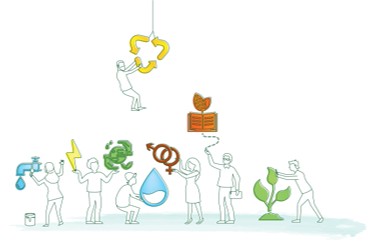Enterprise Profile
This type of enterprise covers a broad spectrum of services along the water use cycle providing an integrated solution for several steps of the service value chain. Commonly, it provides basic waste(water) services to end beneficiaries and turns waste and sanitation end-products to sellable products that target adjacent and more profitable sectors. In doing so, the enterprise provides water or sanitation services to the end customers (B2C), waste(water) management services to governmental (B2G) or business customers (B2B), and in addition sell by-products as an additional revenue stream. While such business models are complex and take time to fully establish, they bear potential to attract both impact-oriented and commercial investments once they have established successful references.
Business Model Features
This type of enterprise offers products and combines it with services across several steps of the value chain. The most common being providing toilets (or waste bins), collecting the waste, processing waste into end-products, and selling the products to businesses.
For the waste collection business, the customer groups are end beneficiaries (B2C), or businesses (B2B) who produce larger quantities of waste(water). By charging the clients for the collection service, the enterprise can often extend it cheaper than fully subsidized government services. Additionally, the enterprise can also engage with governmental actors as clients in this business model (B2G), since they usually hold the mandate to ensure such basic services. Nevertheless, it is still challenging to fully cover the costs solely through charging the clients.
This is why the enterprise offers end-products such as fertilizers or alternative fuel products to break even. These can be sold to businesses (B2B) in adjacent sectors such as agriculture or energy intensive industries, which have a higher willingness to pay. The additional revenue stream ensures the enterprise stays profitable.
Context and Environment
For collection services, the enterprise operates in underserved / off-grid urban areas; while there is limited ability to pay, the lack of alternatives for basic services does lead to the willingness to pay a limited amount of fees.
For the sales of fertilizers (or similar end-products), the enterprise deals with agricultural (rural) areas, and for the sales of fuel products, it deals with urban end-customers or industries. This is the part of the business model that allows generating higher profit margins.
Impact Potential
The enterprise extends basic services to underserved communities, indicating a high level of impact intentionality and additionality. Further, it has added impact by selling sanitation and waste end-products that reduce the stress on natural resources.
Potentially relevant SDG Targets
Water-related impact
SDG 6.1 By 2030, achieve universal and equitable access to safe and affordable drinking water for all.
SDG 6.2 By 2030, achieve access to adequate and equitable sanitation and hygiene for all and end open defecation, paying special attention to the needs of women and girls and those in vulnerable situations.
SDG 6.3 By 2030, improve water quality by reducing pollution, eliminating dumping and minimizing release of hazardous chemicals and materials, halving the proportion of untreated wastewater and substantially increasing recycling and safe reuse globally.
SDG 6.4 By 2030, substantially increase water-use efficiency across all sectors and ensure sustainable withdrawals and supply of freshwater to address water scarcity and substantially reduce the number of people suffering from water scarcity.
SDG 6.6 By 2020, protect and restore water-related ecosystems, including mountains, forests, wetlands, rivers, aquifers and lakes.
SDG 6.a By 2030, expand international cooperation and capacity-building support to developing countries in water- and sanitation-related activities and programmes, including water harvesting, desalination, water efficiency, wastewater treatment, recycling and reuse technologies.
SDG 6.b Support and strengthen the participation of local communities in improving water and sanitation management.
Team and Experience
These complex businesses require a broad range of experiences that is often built throughout the lengthy process of setting up the enterprise, which may take up to ten years. The enterprise needs to set up large scale infrastructure for treatment and resource recovery, which requires technical knowledge and experience with managing governmental stakeholders. Team management, including the ability to manage local partners / franchisees, compliance management, marketing/sales- and finance experience are all critical to deliver services at scale, raise investments, and develop required infrastructure.
Financial Profile
The customer products are low-tech solutions that are often rolled out through franchise- or partnering models with local entrepreneurs, which do not require much R&D or capital expenditure (CapEx). However, the collection service and waste treatment require a higher CapEx into building up the infrastructure.
The enterprise has several revenue streams, including product sales to end customer, collection fees, and sales of waste / sanitation end-products. In some cases, it also has long-term concessions or performance-based contracts with public entities, which are beneficial for commercial financing, especially debt, as it reduces the risk for the capital provider.
In order to attract financing, the enterprise needs to demonstrate a solid financial track record and a concrete projection of revenue growth.
What are your Financing Options?
Grant and Results-based Finance (Impact bond, SIINC, performance-based loan, performance-based contract)
Due to the systemic approach and impact, the enterprise stands a good chance to acquire grant funding to extend its services, if it can prove that the business model allows to achieve sustainable impact at a lower price than public authorities would. In case the enterprise has established solid relationships with public authorities, it may qualify for government grants and PPP financing.
Results-based financing is also very relevant for the enterprise, in case it is not making use of that type of financing already. Given that the enterprise provides products and the relevant services to underserved communities, it is viable to receive funding based on the impact the enterprise creates. The impact measurements should already be part of the operational targets.
Equity or alike (common stock, preferred equity, convertible note)
The enterprise is able to attract equity (or equity-like) financing by leveraging its commercially more viable components in particular. These are usually parts such as recycling facilities that have proven profitable elsewhere already or agricultural products that can be competitive in commercial markets.
Debt or alike (debt, venture debt, subordinated loan, revenue-based loan)
Debt financing can be a viable option, if the enterprise is able to show a track record and demonstrate stable future revenue streams. Recurring revenue streams such as collection fees or government performance-based contracts will be beneficial, in addition to having multiple revenue streams.
Venture debt can be interesting for enterprises who have acquired equity and need additional financing until the next financing round. Revenue-based loans can also be of interest, if the enterprise is not profitable yet, but shows fast growth.


